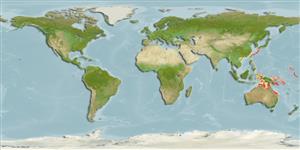分類 / Names
俗名 | 同種異名 | Catalog of Fishes(屬, 種) | ITIS | CoL | WoRMS | Cloffa
Teleostei >
Gobiiformes (Gobies)
鱸形目 (Gobies) >
Gobiidae (Gobies)
鰕虎魚科 (Gobies) > Gobiinae
Etymology: Trimma: Greek, trimma, -atos = something crushed (Ref. 45335); readerae: Named for Sally Reader, Australian Museum..
Environment: milieu / climate zone / depth range / distribution range
生態學
海洋 礁區魚類; 深度上下限 0 - 40 m (Ref. 100726).
分布
國家 | FAO區域 | 生態系 | 發現紀錄 | Point map | 簡介 | Faunafri
Western Pacific: known from mid to outer reefs on the Great Barrier Reef, and inshore reefs of Western Australia, but rarely from the Coral Sea and Timor Sea. Tentatively included, in what appears to represent a species complex, specimens and images collected from the Solomon Islands, Indonesia, Borneo, New Guinea, Japan and the Marshall Islands (also based on the spotting pattern on the cheek).
大小 / 重量 / 年齡
Maturity: Lm ? range ? - ? cm
Max length : 2.6 cm SL 雄魚/尚未辨別雌雄; (Ref. 100726); 2.3 cm SL (female)
簡短描述
型態特徵 | 形態測量圖
背棘 (總數): 7; 背的軟條 (總數): 8-10; 臀棘 1; 臀鰭軟條: 8. This species is distinguished by the following characters: adults with a moderately deep interorbital trench and a shallow groove behind the upper half of the eye, largely disappearing below the papilla at the posterodorsal margin of the eye; predorsal is almost completely covered with ctenoid scales, with 3-6 rows crossing the midline anteriorly to just behind the interorbital trench, anterior-most scale on the midline just behind a small naked patch posterior to the eyes, the scale not larger than the second scale on the midline; no scales on opercle and preopercle; pectoral-fin base is covered with 5-6 large cycloid scales, lowermost 3-4 scales smaller than upper two scales; prepelvic area with a small scale covering basal membrane between the two fins and followed anteriorly by a large scale between the bases of fins, and 3 rows of large cycloid scales anteriorly; central pectoral rays are branched; pelvic fins are widely separate, connected only at their bases, the distance between the bases of the fins about three-quarters to equal to the base of each pelvic fin; the fifth pelvic ray is usually unbranched, rarely with a single branch (2 terminal tips); fifth ray 60-80% the length of the fourth; the second dorsal spine usually longest, elongated into a long filament in adult males, reaching to beyond the end of the second dorsal fin, while females sometimes with a short filament reaching to above the anterior rays of the second dorsal fin; the third spine sometimes a short filament; D2 usually I 9 and anal rays usually I 8; below the eye are two distinct round red to reddish-orange spots; the branchiostegal membranes with distinct bright reddish-orange spots; body possess small yellow to red spots in 4-5 irregular rows anteriorly and three rows on the caudal peduncle (Ref. 100726).
This species is usually found in back reef leeward areas (Ref. 100726).
Life cycle and mating behavior
成熟度 | 繁殖 | 產卵場 | 卵 | 孕卵數 | 仔魚
Winterbottom, R. and D.F. Hoese, 2015. A revision of the Australian species of Trimma (Actinopterygii, Gobiidae), with descriptions of six new species and redescriptions of twenty-three valid species. Zootaxa 3934(1):001-102. (Ref. 100726)
IUCN 瀕危狀態 (Ref. 130435)
無危 (LC) ; Date assessed: 07 September 2021
人類使用
更多資訊
國家FAO區域生態系發現紀錄簡介Stocks生態學食性食物相食物消耗量定量
俗名同種異名新陳代謝捕食者生態毒物學繁殖成熟度產卵場產卵群集孕卵數卵卵發育
年龄/大小成長長度-重量長度-長度長度-頻率形態測量圖型態特徵仔魚稚魚動力學入添量豐度BRUVS
參考文獻養殖養殖資訊品種遺傳學Electrophoreses遺傳率疾病加工NutrientsMass conversion
合作者照片Stamps, Coins Misc.聲音神經毒速度泳型鰓區Otoliths腦重體重比眼睛色素
工具
特別的報告
下載 XML
網路資源
Estimates based on models
Phylogenetic diversity index (Ref.
82804): PD
50 = 0.5000 [Uniqueness, from 0.5 = low to 2.0 = high].
Bayesian length-weight: a=0.01023 (0.00477 - 0.02194), b=3.02 (2.84 - 3.20), in cm total length, based on LWR estimates for this (Sub)family-body shape (Ref.
93245).
回復力 (Ref.
120179): 高度, 族群倍增時間少於 15個月 (Preliminary K or Fecundity.).
Fishing Vulnerability (Ref.
59153): Low vulnerability (10 of 100).
